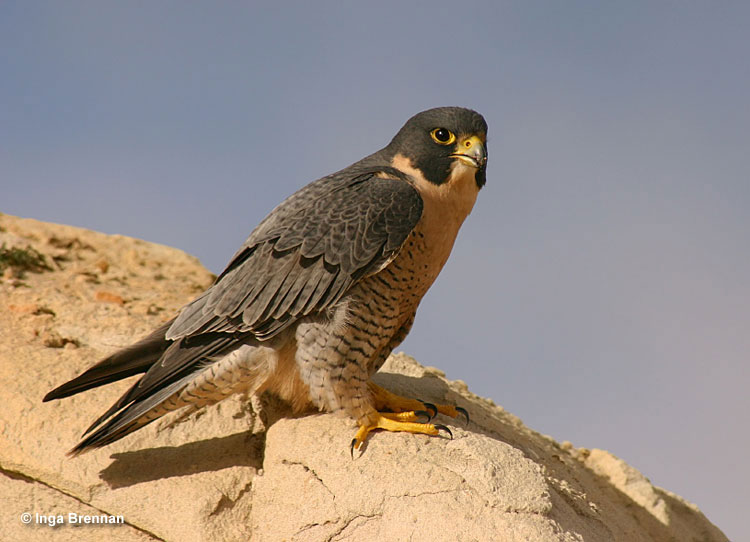Peregrine Falcons (Falco peregrinus) are known as the fastest birds on Earth.
They range throughout all the continents except for Antarctica and mostly inhabit open areas. These capable hunters can take down prey from small insects to larger birds and are therefore prized in falconry.
Dive in and learn more about those amazing creatures!
On this page
Identification
You can recognize a Peregrine Falcon by its shape and size. They have long, pointed wings and an elongated tail that is rounded at the tip. This species is about the size of a crow, measuring 13-23 inches long with a wingspan of 29-47 inches.
As with other raptor species, male Peregrine Falcons are smaller compared to their female counterparts. Females are about 15-20% bigger and 40-50% heavier.
But that is about as far as the sexual dimorphism goes. Adult Peregrine Falcons have the same plumage regardless of sex.
They have bluish-gray upper parts with somewhat faint black barring, pale undersides with dark barring, and a bluish-gray “helmet” around their head that contrasts against the pale sides of the neck and white throat. Their hooked bills and claws are black whereas their feet and the base of their bill (also known as “cere”) are yellow.
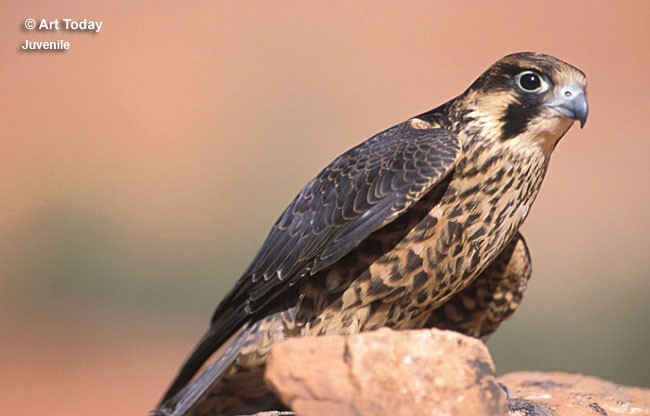
Juvenile Peregrine Falcons are a bit paler and browner than adults. They have gray uppersides and buffy underparts that are vertically streaked with brown. Their faces are paler as they don’t have the full “helmet” yet.
You can also distinguish between juveniles and adults while they’re in flight. Adults have a white underside that is barred in black, a pure white throat, black wingtips, and a dark tail that has dark barring, a black tip, and a white band at the very end.
Juveniles have whitish undersides, are more boldly streaked including on the throat, and have fine barring on the feathers and tail.
Vocalizations
Peregrine Falcon’s call is a series of sharp, high-pitched kaa-a-aack kaa-a-aack or similar but rapid kak-kak-kak. It’s used to raise alarm. They also chitter and give sharp kee-kee-kee calls when hunting.
Food
Peregrine Falcon’s diet primarily consists of birds which can make up 77-99% of what they eat.
They’re formidable and highly skilled hunters, preying on up to 2,000 species, but often on birds from the Columbidae family.
Prey items include doves, pigeons, grouse, waterfowl, smaller songbirds, ducks and other shorebirds, geese, gulls, jays, starlings, bats, fish, and rodents. They’ve gone for creatures as small as insects and as big as Sandhill Cranes.
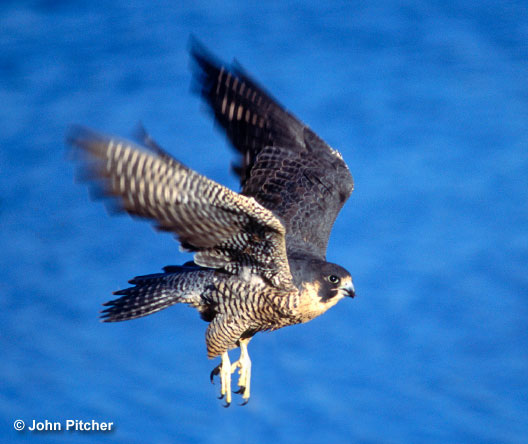
These falcons hunt using a diverse range of strategies tailored to their prey and environment.
Their preferred method is perch-hunting, where they perch on an elevated vantage point, scan the surroundings, and then fly after the prey, capture it with their claws, and kill it with their bill.
They may also hover in the wind, fly high in the sky and then dive-bomb, but also walk on the ground to snack on insects or fly low over water or ground to quickly snatch their prey.
If the prey is big, they will fly high and then knock them out by dive-bombing it and then feed on it on the ground. Smaller creatures are eaten in flight. Typically, though, they carry their catch back to the perch and eat it there.
Nesting and Eggs
These falcons mate for life and nest in the same place every year. Their courtship flight is a spectacle of aerobatics that blend together spirals, sharp dives, and daring maneuvers. You may even see the female flying upside down to accept prey from the male.
Peregrine Falcons nest on cliff edges, particularly beneath overhangs. However, they may also choose to nest in large hollows in trees, steep slopes, bridges, and towering buildings, or reuse abandoned nests from other large birds.
The male scouts for locations, whereas the female Peregrine Falcon makes the final choice and then scrapes a depression to lay her eggs in.
Peregrine Falcon eggs are 2 inches long, whitish to pale rusty, marked with warm brown. They only have one brood per season with 2-6, mostly 3-4 eggs in a clutch. The female does most of the incubating, which lasts for 29-35 days, while the male hunts and feeds her.
In the beginning, the female stays with the young while the male hunts and provides for the family. As the nestlings grow older, the female starts hunting as well and parents start dropping food to them from the air.
The younglings fledge at around 35-49 days after hatching and gain independence some weeks after that.
Current Situation
Peregrine Falcons range throughout all the continents except for Antarctica. In North America, they’re resident along the northwest coast and in some temperate regions and breed in northernmost North America and parts of the western United States.
Nonresident populations migrate to South America for the winter.
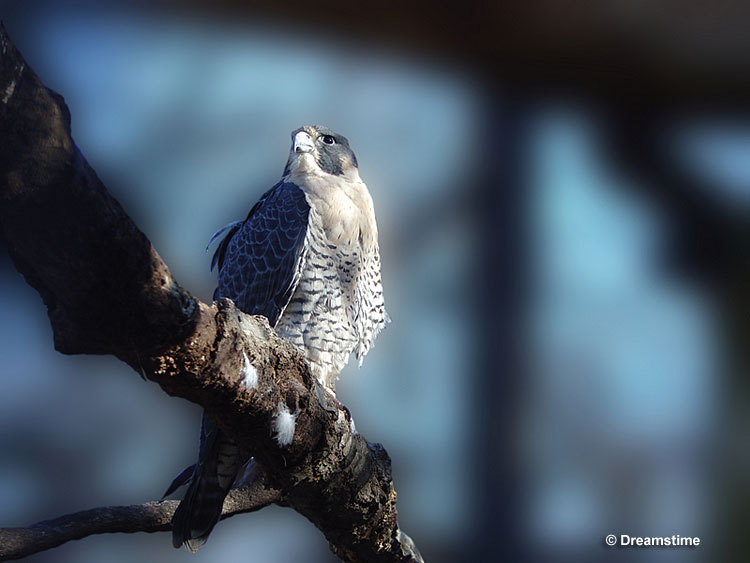
You can find these falcons in almost any open area with suitable nesting sites. Peregrine Falcon habitats include coastlines, grasslands, mountains, cliffs, tundra, desert mountains, and sometimes even cities.
Peregrine Falcons are listed as of least concern on the IUCN Red List due to their wide range and sizable population. Their numbers had dropped in the middle of the 20th century but have since recovered thanks to the restriction on harmful chemicals and successful breeding and reintroduction programs.
Related: What do falcons symbolize?
Facts
- Peregrine Falcon’s dive and top speed are what make this raptor so special. Their highest recorded dive speed was 242 mph, making them the fastest birds (and creatures) on Earth! However, when they’re not dive-bombing unsuspecting prey, then their speed stays around 25-34 mph when flying normally and goes up to 69 mph when chasing prey.
- Peregrine Falcons are well-respected in falconry and have been used for over 3000 years. They’re versatile, very susceptible to training, good hunters, available via captive breeding, and can hunt anything from small to large game birds.
- Peregrine Falcons are found on all continents (except for Antarctica), and over time different populations have developed into distinct subspecies with appearances. There are 19, to be exact, although some consider some of the subspecies a separate species. In North America, you can meet three – tundrius, anatum, and pealei.
- Although rare in the wild, they can hybridize with other raptors such as the Lanner’s Falcon and Merlin.
- Here are some other names you can call Peregrine Falcons. Male falcons are called tiercels and falcon chicks are called eyases. If you see a group of them, you can call them a kettle, but also a bazaar or an eyrie. This species is also known as the duck hawk.
Similar Species
You may easily mix up Peregrine Falcons with other falcons. Here are some tips to tell them apart.
Prairie Falcon
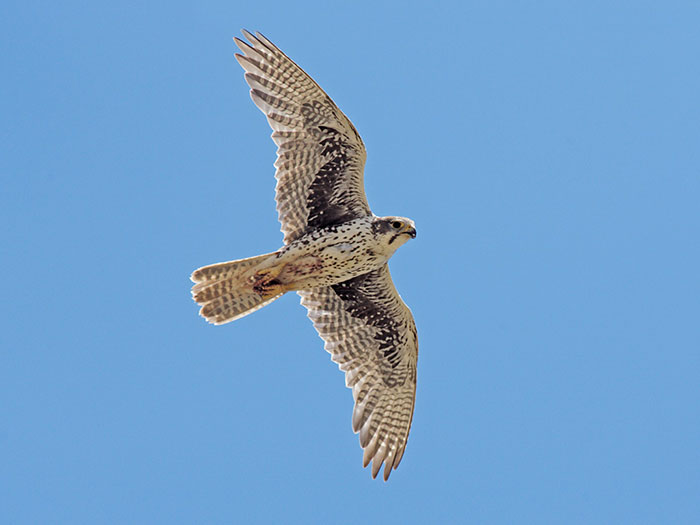
Prairie Falcons are only found in the western United States, with their range slightly extending to Canada and Mexico.
Adult Prairie Falcons have a brown tone to their plumage, whereas Peregrine Falcons are darker and bluish-gray. Although their underside is marked, it isn’t barred like the Peregrine’s.
They also have a white patch on their cheeks. Immatures Prairies are paler, browner, and have darker wing linings.
Merlin
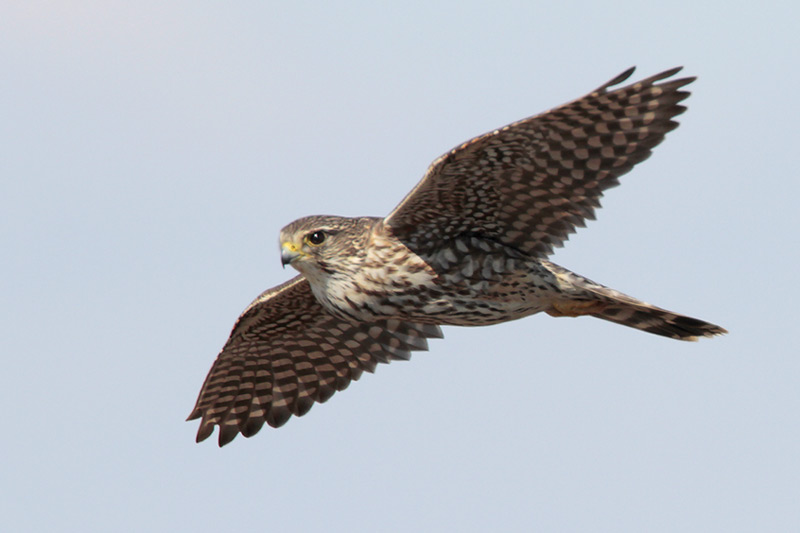
Merlins are generally smaller than Peregrines and have a more compact look. They have similar plumage and coloration, but they have lighter heads and lack the “helmet.”
Gyrfalcon
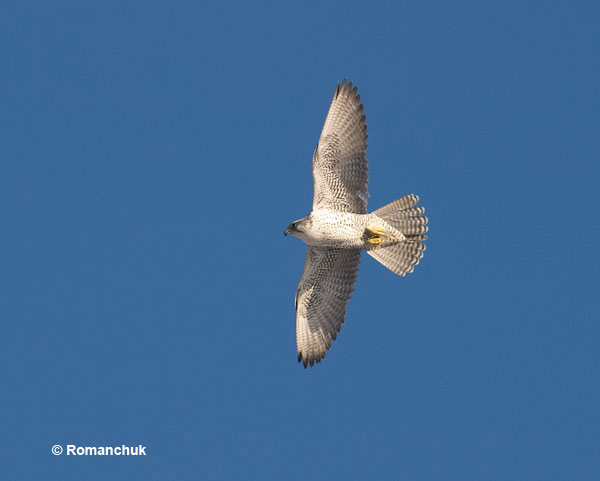
At first glance, you may confuse a Gyrfalcon’s gray morph for a Peregrine Falcon.
However, in North America, Gyrfalcons are only found in the arctic and subarctic regions, with their wintering range extending into the northernmost U.S. Gyrfalcons are also bulkier and have a wider tail.
The adult gray morph has a pale head, lacks the “helmet”, and isn’t as uniformly gray as the Peregrine Falcon.
Frequently Asked Questions
Are Peregrine Falcons the fastest birds?
Peregrine Falcons are the fastest birds when it comes to diving from the sky. The highest recorded speed reached 242 mph.
What is special about Peregrine Falcons?
Peregrine Falcons reach the highest speed while plummeting from the sky and they are highly regarded in falconry.
How rare is it to see a Peregrine Falcon?
Within its range, it isn’t rare to see a Peregrine Falcon since they now also frequent many cities.
How can you tell a hawk from a Peregrine Falcon?
In short, Peregrine Falcons have pointed and slender wings, round and short heads, and fly with brief and rapid wingbeats, whereas hawks generally have wide, short, and rounded wings, smooth and pointy heads, and fly on slower wingbeats intercepted by glides.
Where are Peregrine Falcons most commonly found?
Peregrine Falcons are most commonly found along coastlines and mountain ranges – somewhere near cliffs.
What does it mean when a Peregrine Falcon visits you?
A Peregrine Falcon’s visit can mean many things, including that you should focus on your future, plan ahead, and stay vigilant, but it may also serve as a reminder that you have strength and skill.

